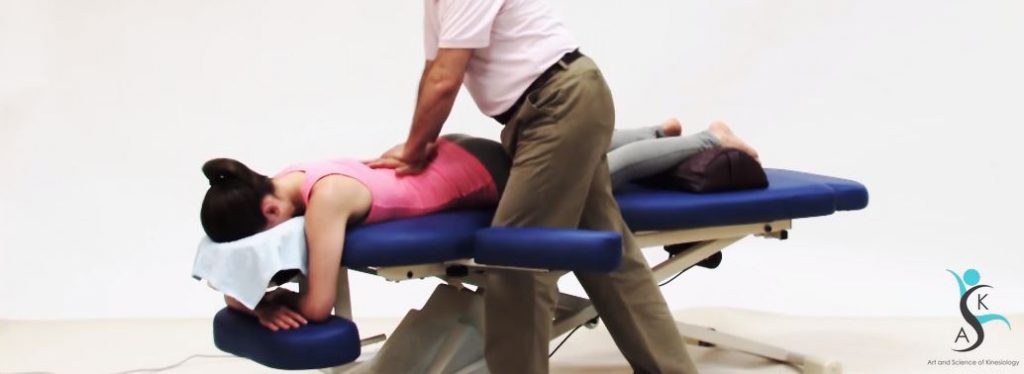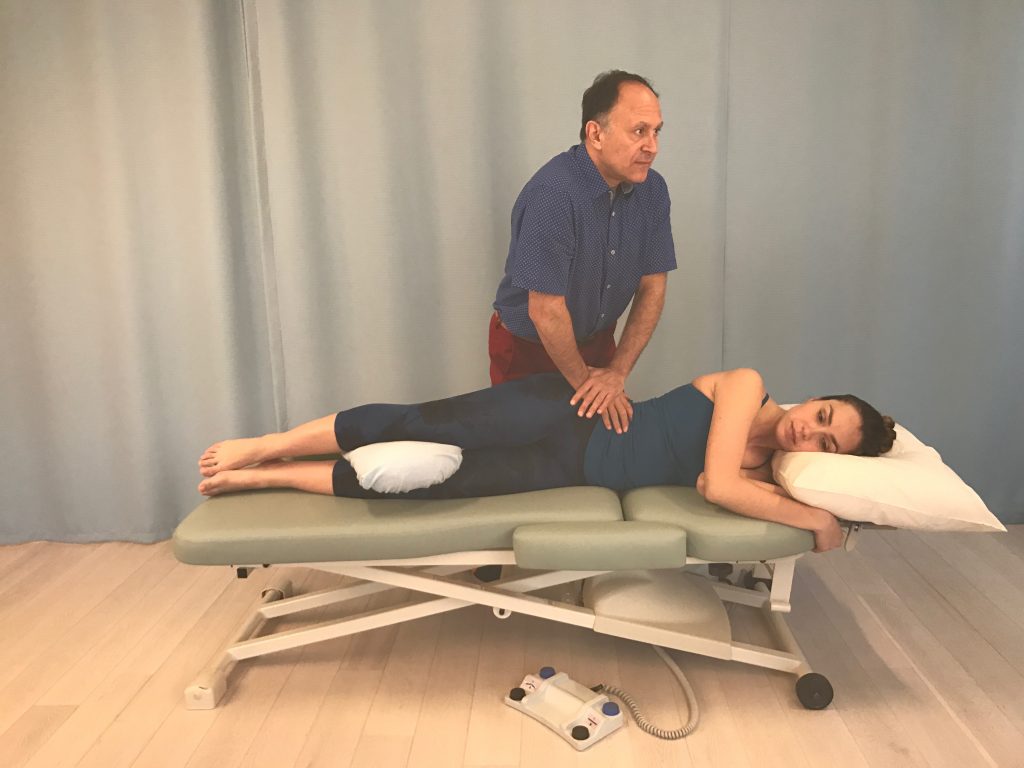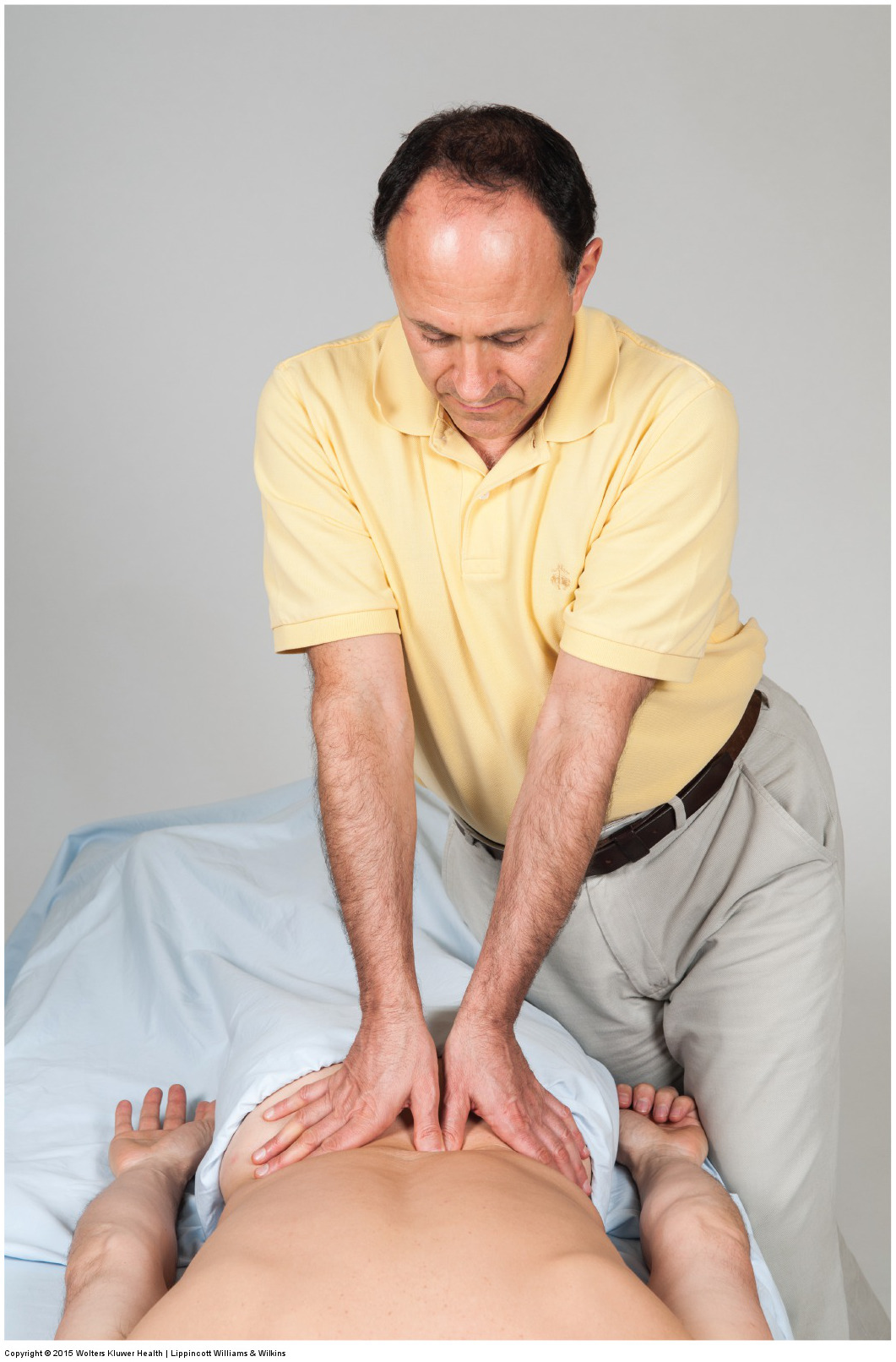This is the 2nd in a series of 13 articles on Deep Pressure Massage Technique for the Low Back
Massage Table Height and Width

Permission Joseph E. Muscolino. www.learnmuscles.com
Choosing the right massage table can be critically important to good body mechanics. The two most important parameters when considering body mechanics are its width and height.
Massage Table Width
When considering the width of a massage table, two competing concepts are client comfort and therapist body mechanics. The wider it is, the more comfortable it is for the larger client. However, a wider table places the client farther from the therapist and forces the therapist to work much harder to position the core over the client’s body. This often results in the therapist having to lean over and compromise his body mechanics. In effect, having a wide table provides comfort for the occasional large client, but the therapist must struggle with all the rest of the clients.
Possible compromises include tables that have sidepieces that can make it wider for the larger client but be removed when working with smaller clients. Or there can be a scoop in its contour in the middle that narrows its width around the low back and pelvis of the client (see accompanying figure). This allows the therapist to place his core closer to the client for efficient body mechanics. Another feature that some tables have is additional face cradle holes that allow for the face cradle to be moved to one side, thereby allowing the client to lie closer to the side of the table. This prevents you from having to lean over, thereby reducing stress to your back. It also allows you to get your core in closer to the client, permitting more efficient use of your body weight and the engagement of larger muscles. If your table has these holes, it is wise to take advantage of them for better body mechanics.
Massage Table Height

Using Body Weight with a low table. Permission Joseph E.Muscolino. www.learnmuscles.com
Even more important than the width is the height. As a rule, when generating deep pressure, you want the table to be as low as possible so that you can more easily position your body above the client to take advantage of gravity and body weight. It is likely that the most common error when trying to employ efficient body mechanics is that the therapist positions the table too high. This likely happens because many therapists begin their massage /soft tissue manipulation education in school with classes that teach light pressure work. Therefore, it is easy to work with the table high. Often, the therapist becomes accustomed to keeping the table at this height even though deeper pressure techniques are later learned and employed. With the table too high for the techniques now being used, the therapist struggles to achieve pressure, believing that he or she is too weak when the real culprit is a table that is too high. Even though most tables are adjustable in height, it is important to choose a table that can go low enough so that the top of the table is well below the bottom of your knee joint.
Electric Lift Table
For any therapist who has a stationary practice in one location, it is an extremely wise decision to buy an electric lift massage table. This allows easy adjustment of the height with the touch of a pedal. Adjusting the height is not only important between clients of different sizes but it is also important when working on the same client if the client changes position, such as when changing from supine or prone to side-lying. It is also important when changing contacts that are used to work on the client. For example, work with thumb or finger pads requires a far lower table than work with the elbow or forearm. Further, there are many stretches for the low back and pelvis that require the table to be very low and others that require the table to be high. It is logistically impossible to change the height of a manual table between each of these stretches. The purchase of an electric lift table is an investment in the quality of your practice as well as an investment in your success!
Choosing the Right Lotion/Oil (Lubricant)
When strokes are performed, to glide along the client’s skin without abrading it, a lotion/balm/oil (lubricant) of some kind is needed. Choosing the right one is very important, especially for deep tissue massage. A lubricant allows the therapist to slide/glide along the client’s skin. However, a lubricant must also provide some drag or friction that helps you press down into the client’s tissues. Otherwise, the skin will be too slippery, causing you to slide along the surface of the skin without being able to generate pressure into the client’s tissues. Each lubricant has a balance of slide and drag. For deep tissue work, it is important to choose one that offers more drag than slide. Generally, water-based lotions are better than oils for deep tissue work.
The amount of lubricant used is also very important. Too much lubricant increases the slide along the skin, making it difficult to generate pressure down into the tissues. Many therapists have difficulty generating deep pressure not because of a lack of strength but rather because they use too much lubricant. As a general rule, the least amount needed to not abrade the client’s skin is the amount that should be used.
This is the 2nd of 13 articles on Deep Pressure Massage for the Low Back.
The thirteen articles are:
- Introduction to Deep Pressure Massage to the Low Back
- Deep Pressure Massage to the Low Back – Choosing the Right Table
- Deep Pressure Massage to the Low Back – Overview
- Deep Pressure Massage to the Low Back – Client and Therapist Positioning
- Deep Pressure Massage to the Low Back – Positioning the Feet
- Deep Pressure Massage to the Low Back – Choosing the Treatment Contact
- Deep Pressure Massage to the Low Back – Support Your Treatment Contact
- Deep Pressure Massage to the Low Back – Use Stacked Joints
- Deep Pressure Massage to the Low Back – Apply Pressure Perpendicularly
- Deep Pressure Massage to the Low Back – Use Body Weight
- Deep Pressure Massage to the Low Back – Tissue Tension Barrier
- Deep Pressure Massage to the Low Back – Deep Strokes
- Deep Pressure Massage to the Low Back – Forward Head Posture
(Click here for the blog post article: Neck Deep Pressure Massage: Overview.)


